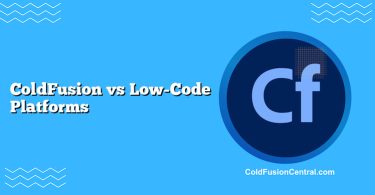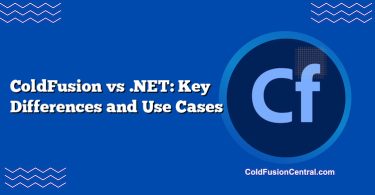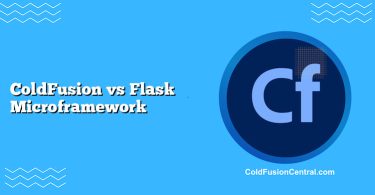Definitions
What is ColdFusion?
ColdFusion is a rapid web application development platform centered around the CFML language. Originally created by Allaire and now maintained by Adobe (with the open-source Lucee as a popular alternative), ColdFusion runs on the JVM and exposes an application server with built-in features for templating, database access, caching, PDF generation, scheduled tasks, and integration services. It is typically deployed on virtual machines or bare metal behind web servers like IIS, Apache, or Nginx.
What is Serverless?
Serverless (often implemented as Functions-as-a-Service, or FaaS) is a cloud execution model where you deploy individual functions that run on demand. The cloud provider manages provisioning, scaling, and server maintenance. Common platforms include AWS Lambda, Azure Functions, Google Cloud Functions, and Cloudflare Workers. You pay primarily for the compute time and requests, not for idle server capacity.
Overview
Architectural Model
- ColdFusion: A stateful application server running CFML, usually hosted on one or more VMs or containers. It often serves as a monolith or a small set of services, with in-process caches and session state.
- Serverless: A stateless, event-driven model where functions are invoked by triggers (HTTP/API Gateway, queues, events, schedules). State is externalized to databases, caches, or object storage.
Supported Platforms and Runtimes
- ColdFusion platforms:
- Operating systems: Windows, Linux (common), macOS (dev).
- Web servers: IIS, Apache HTTPD, Nginx (via connectors/proxies).
- Distributions: Adobe ColdFusion (licensed), Lucee (open source).
- JVM-based, can integrate Java libraries.
- Serverless runtimes:
- AWS Lambda: Node.js, Python, Java, .NET, Go, Ruby; custom runtimes and container images.
- Azure Functions: Node.js, Python, .NET, Java, PowerShell, Go (extensions), custom handlers.
- Google Cloud Functions/Cloud Run: Node.js, Python, Go, Java, .NET, Ruby, PHP (via Cloud Run).
- Cloudflare Workers: JavaScript/TypeScript, WebAssembly.
Key Features
ColdFusion Highlights
- Rapid development with CFML tags and script syntax.
- Built-in services: PDF generation, image manipulation, mail, scheduled tasks, query-of-queries, document services.
- Mature JDBC integration and ORM (Hibernate).
- Enterprise features: caching (EHCache), security hardening tools, API Manager (Adobe CF), and Admin UI for configuration.
- Strong for legacy systems and quick CRUD-centric apps.
Serverless Highlights
- Auto-scaling to zero and horizontal scale-out with minimal ops overhead.
- Event-driven integrations with queues, streams, object storage, and API gateways.
- Fine-grained billing per request and duration (no cost for idle).
- Global edge compute options (e.g., Cloudflare Workers) for low-latency.
- Ecosystem support: managed databases, queues, event buses, workflow orchestration (e.g., AWS Step Functions).
Performance
Latency and Throughput
- ColdFusion:
- Predictable performance once the JVM is warm.
- Low per-request latency when instances are right-sized and caches are hot.
- Throughput increases with vertical scaling (more CPU/RAM) and horizontal scaling (more CF instances).
- Serverless:
- Low average latency for warm executions.
- Potential cold-start latency for infrequently invoked functions, especially on heavier runtimes like Java or .NET. Lighter runtimes (Node.js, Python) tend to start faster.
- Scales horizontally with concurrent executions bound by account limits.
Cold Starts and Warm Pools
- ColdFusion keeps an application server running; no cold starts per request, but JVM warm-up after deployment or restart is needed.
- Serverless may incur cold starts if functions haven’t run recently. Techniques to mitigate cold starts include:
- Selecting faster runtimes (Node.js/Python) or lighter frameworks.
- Provisioned concurrency (AWS Lambda).
- Keeping functions small and focused.
Long-Running Tasks
- ColdFusion can handle long-running requests or background jobs using scheduled tasks or async patterns; cost is tied to the server instance, not per-minute runtime.
- Serverless often has maximum execution duration (e.g., AWS Lambda default hard limit, although it has increased over time). Long-running or CPU-bound tasks may be better on containers/VMs or split into smaller, chained functions with workflow orchestrators.
Scalability
ColdFusion Scaling Patterns
- Vertical scaling: allocate more CPU/RAM to the JVM.
- Horizontal scaling: run multiple CF instances behind a load balancer (use sticky sessions or external session storage).
- Use distributed caches (Redis), message queues, and database connection pooling.
- Requires capacity planning, monitoring, and ops for elasticity and high availability.
Serverless Scaling Model
- Automatic, granular scaling per function in response to events.
- Concurrency controls allow throttling or reserved capacity.
- No servers to manage; elasticity is handled by the provider.
- State must be externalized (e.g., DynamoDB, Firestore, Redis, S3), which influences architecture and latency.
State, Sessions, and Data
- ColdFusion can store sessions in memory (fast) or in a shared store for clustering (slower but scalable).
- Serverless is stateless by design; session/state management relies on external stores or stateless JWT tokens.
Security
Responsibility Model
- ColdFusion: You handle OS/JVM/CF patches, firewalling, TLS termination, and hardening. Use WAFs (e.g., AWS WAF, Cloudflare), secrets managers, and CI/CD scanning.
- Serverless: The cloud provider secures the underlying infrastructure. You secure application code, IAM permissions, secrets, input validation, and data stores.
Common Pitfalls
- ColdFusion: Unpatched servers, permissive Admin endpoints, insecure data sources, outdated libraries.
- Serverless: Overly broad IAM roles, public endpoints without authentication, event injection, secrets in environment variables without proper rotation.
Cost
Cost Drivers for ColdFusion
- Licensing: Adobe ColdFusion licenses can be significant per core or per server. Lucee removes license fees but not hosting and ops costs.
- Hosting: VMs/containers, load balancers, storage, bandwidth.
- Operations: Monitoring, patching, backup, scaling management, on-call.
- Idle capacity: You pay for servers even when traffic is low.
Cost Drivers for Serverless
- Requests and duration billed at per-invocation granularity; no cost when idle.
- Additional services: API Gateway, message queues, databases, logs, and NAT gateways can add cost.
- Cold start mitigation (provisioned concurrency) incurs baseline charges.
- High sustained throughput or long-running workloads can become expensive compared to reserved VMs/containers.
Sample Cost Scenarios (High-Level)
Low/Variable Traffic API (spiky usage)
- Serverless:
- Example: 2 million requests/month, ~200 ms average, 512 MB memory.
- Rough compute + request cost is typically only a few dollars.
- Result: Very cost-effective due to zero idle.
- ColdFusion:
- Even a small VM running 24/7 incurs monthly costs, plus any licensing.
- Result: More expensive at low loads.
Steady, High Throughput 24/7
- Serverless:
- Costs scale linearly with requests and duration. With sustained heavy use or long durations, monthly costs can grow considerably.
- ColdFusion:
- Fixed monthly cost for servers; with good utilization and reserved capacity, unit cost per request can be lower.
- Result: Potentially cheaper if traffic is predictable and high, especially on Lucee/open-source stacks.
Heavy CPU/Long-Running Jobs
- Serverless:
- Execution time and memory drive costs; time limits may require re-architecture.
- ColdFusion/Containers:
- Dedicated instances for batch windows can be more predictable and easier to optimize.
Side-by-Side Comparison
| Aspect | ColdFusion (Adobe CF/Lucee) | Serverless (AWS Lambda, Azure Functions, etc.) |
|---|---|---|
| Performance | Stable latency on warm JVM; no per-request cold start | Fast when warm; potential cold starts; global edge runtimes can be very low latency |
| Scalability | Manual scaling (vertical/horizontal); clustering & load balancing | Automatic, event-driven scaling; concurrency controls; scales to zero |
| Cost Model | Pay for servers 24/7; license (Adobe CF); ops overhead | Pay per request/duration; minimal idle cost; ancillary service costs |
| Use Cases | Legacy CFML apps, intranet portals, PDF/reporting, integrated back-office | Event-driven APIs, bursty traffic, IoT, ETL, image/video processing, cron |
| State Management | In-process or shared sessions; easier server-side sessions | Stateless by design; externalize state (DB/cache) |
| Security | You patch and harden OS/JVM/app; WAF optional | Provider secures infra; you manage IAM, code, data stores |
| Dev Velocity | Very rapid for CFML teams; built-in features | Rapid for microservices; strong CI/CD; polyglot |
| Vendor Lock-in | CFML ecosystem; easier to lift-and-shift VMs | Platform services can create lock-in; portability varies |
| Pros | Rapid development, integrated features, predictable performance | Auto-scaling, low idle cost, event integrations, global reach |
| Cons | License/hosting cost, scaling overhead, smaller talent pool | Cold starts, state externalization, cloud-specific patterns |
Real-World Use Cases
When ColdFusion Shines
- Scenario: A medium-sized enterprise runs a 15-year-old intranet application with extensive CFML templates, scheduled reports, and PDF generation. The app integrates with on-premise ERP and uses Windows authentication.
- Why ColdFusion:
- Minimal rewrite effort; keep CFML codebase and leverage built-in PDF/reporting features.
- Straightforward lift-and-shift to modern VMs or containers.
- Predictable performance and simpler session management.
- Cost and scalability:
- Use Lucee to reduce license costs, scale with multiple CF instances behind a load balancer, and apply caching to handle peak reporting hours.
- Why ColdFusion:
When Serverless Wins
- Scenario: A consumer-facing image upload API experiences unpredictable spikes (marketing campaigns, seasonal traffic). Each upload triggers virus scanning, thumbnail creation, and metadata extraction.
- Why Serverless:
- S3/object storage event triggers fan-out functions; auto-scaling for bursts.
- Pay only when uploads occur; no idle servers.
- Integrate with managed queues (SQS), Step Functions for orchestration, and a CDN for global distribution.
- Cost and scalability:
- Low cost for low/medium volumes; horizontally scales without ops involvement.
- Use provisioned concurrency only for the hottest paths if latency targets require it.
- Why Serverless:
Pros and Cons
ColdFusion Pros
- Rapid development with CFML and rich built-in services.
- Stable performance without per-invocation cold starts.
- Easier session/state handling inside the app server.
- Mature JDBC and PDF/reporting integrations.
ColdFusion Cons
- Potentially high license costs (Adobe CF) and continuous hosting expenses.
- Manual scaling and capacity planning; more ops overhead.
- Smaller hiring pool; perceived legacy technology risks.
- Monolithic patterns may slow large-scale agility.
Serverless Pros
- Auto-scaling with minimal ops; scales to zero.
- Cost-effective at low or spiky traffic; fine-grained billing.
- Event-driven integrations with queues, streams, and storage.
- Polyglot development; easy to compose microservices.
Serverless Cons
- Cold starts can affect latency-sensitive workloads.
- Statelessness requires externalizing sessions and caching.
- Service limits, IAM complexity, and potential vendor lock-in.
- Long-running or CPU-bound tasks can be costlier or require re-architecture.
Decision Factors / Which One Should You Choose?
Quick Checklist
- Existing CFML codebase and team expertise? → Favor ColdFusion/Lucee.
- Highly variable or spiky traffic with many event triggers? → Favor Serverless.
- Strict low-latency SLAs with heavy use of Java/.NET? → ColdFusion or Serverless with provisioned concurrency and lighter runtimes.
- Long-running, CPU-intensive batch jobs? → Consider ColdFusion on VMs/containers or containerized services, not pure FaaS.
- Budget focused on minimizing idle cost and ops? → Serverless.
- Predictable 24/7 high throughput and cost control? → ColdFusion/Lucee or containers with reserved capacity.
Hybrid Approach (Often the Best)
- Keep a core ColdFusion app for CFML-heavy features and internal workflows.
- Offload bursty, event-driven tasks (image processing, ETL, scheduled jobs) to Serverless functions.
- Use shared services (Redis, S3, queues) to bridge the two worlds.
- Incrementally modernize without a risky full rewrite.
Key Takeaways / Summary Points
- ColdFusion offers predictable performance, integrated features, and is ideal for teams with CFML expertise or existing CF-based systems. Cost is dominated by licensing/hosting and ops.
- Serverless delivers auto-scaling and pay-per-use economics, excellent for bursty workloads and event-driven architectures, with trade-offs in cold starts and state management.
- For pure cost efficiency: serverless is usually cheaper at low/variable loads; VM/container-based ColdFusion (especially Lucee) can be more economical at sustained high loads.
- The best strategy is often hybrid: keep what ColdFusion does best, and use Serverless where elasticity and event-driven patterns shine.
FAQ
How hard is it to migrate a ColdFusion application to Serverless?
Migrating a sizable CFML app directly to Serverless can be complex because of stateful patterns, in-process sessions, and tightly coupled features like PDF generation. A phased approach works best: extract specific features (e.g., image processing, scheduled tasks) into serverless functions while retaining the core CF app initially.
Can I run ColdFusion in containers alongside Serverless?
Yes. Many teams containerize ColdFusion (Adobe CF or Lucee) and deploy on Kubernetes or ECS, then integrate with Serverless for asynchronous tasks. This model provides predictable performance for the app layer and elastic scale for event-driven workloads.
What about cold starts on Serverless—are they always a problem?
Not always. Lightweight runtimes (Node.js, Python) generally have fast cold starts. For latency-critical endpoints, use provisioned concurrency or keep functions warm with scheduled pings. Architectural choices (smaller packages, fewer dependencies) also help.
Is Lucee a viable alternative to Adobe ColdFusion for cost savings?
Yes. Lucee is a popular open-source CFML engine that eliminates licensing fees, often making VM/container deployments more cost-effective. Validate compatibility with your codebase and third-party libraries before switching.
Which serverless provider is best for large-scale APIs?
AWS Lambda with API Gateway is a common choice due to ecosystem breadth, but Azure Functions and Google Cloud Functions are equally strong options depending on your existing cloud investments. For ultra-low latency at the edge, consider Cloudflare Workers with a global network.




